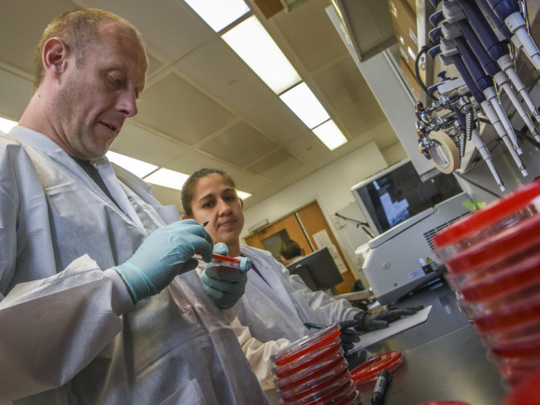
Microbiologist Patrick McGann knew he had identified a dangerous germ. He just didn’t know how dangerous.
In mid-May, a colleague had found a strain of E. coli bacteria from a 49-year-old Pennsylvania woman that tested positive for resistance to a drug called colistin. That’s the antibiotic used when all others fail.
McGann, whose job is to prevent outbreaks of new pathogens in the US military’s sprawling healthcare system, wasn’t yet alarmed. Sometimes mutations occur spontaneously that make bacteria resistant to an antibiotic. It would be a completely different problem, though, if the bacteria turned out to carry a certain colistin-resistance gene called mcr-1.
But that required deeper molecular testing. McGann asked his research team at the Walter Reed Army Institute of Research in Silver Spring, Maryland, to do an initial test for the presence of the resistance gene. And on May 18, he got the result as he rode Metro’s Red Line back to the lab from a meeting.
Research technician Ana Ong texted him to say the strain of E. coli had tested positive for the mcr-1 gene.
Stunned, McGann texted back: “You’re [expletive] me??” And then, realising what the discovery meant, he didn’t wait for her reply.
“On to the sequencer ASAP,” he wrote back, referring to the labour-intensive, round-the-clock effort required to read the entire genetic code of the bacteria and determine how easily the gene might spread.
“We had to drop everything else to get this done,” he explained later. “When [the test] came back positive, all hell broke loose.”
US health officials and experts had been bracing for this moment since the gene’s discovery late last year in China. They’d hunted for mcr-1 in tens of thousands of samples from meat sources, animals and people.
And now that it’s definitively here, officials expect to find more cases — provoking even greater alarm. Immediately, the discovery in Pennsylvania gave new urgency to measures throughout the military and federal government to determine where else the gene might be lurking and how to control its spread.
For infectious-disease experts, the nightmare scenario is for the gene to spread to bacteria that are now susceptible only to colistin. That would make them invincible to any antibiotic, unstoppable by the most lifesaving drugs of modern medicine.
The gene mcr-1 was first reported from China and it then spread across Asia and Europe. By March, there were even more reports from France, Switzerland, Malaysia, Brazil and Argentina.
Still, the gene remains relatively rare. After the initial report from China, McGann’s team tested more than 3,000 antibiotic-resistant bacteria that had been collected from military facilities around the world. None contained the mcr-1 gene.
The Centers for Disease Control and Prevention estimates that drug-resistant bacteria cause 2 million illnesses and 23,000 deaths each year in the United States. Many service members wounded during the Iraq War contracted a strain of bacteria that the media later dubbed “Iraqibacter”. The normally harmless bacteria, found in soil and on skin, got into wounds and caused stubborn bloodstream infections, many of them resistant to many types of antibiotics. After about 2007, colistin was often one of the most effective treatment options available, McGann said.
That’s one reason the Army created the Multidrug-resistant Organism Repository and Surveillance Network (MRSN) in 2009; McGann is its chief of molecular research and diagnostics. Researchers say the detection of colistin-resistant bacteria in the Pennsylvania woman was the result of this strong surveillance system but also sheer luck.
McGann got the initial call about a resistant E. coli sample from Kurt Schaecher, chief of the infectious diseases laboratory at Walter Reed National Military Medical Center in Bethesda. The Bethesda hospital has the reference lab for about 100 military facilities, which regularly send it drug-resistant organisms.
Schaecher, who had just started in the job, was troubled by the number of reports coming in from around the world about the mcr-1 gene. Testing for colistin resistance was not routinely done in the lab, but he thought it would be prudent to start.
On May 12, he pulled out six of the lab’s most recent samples to test for resistance to colistin. The next day, the results were back. “And lo and behold, this one popped up,” he recalled, referring to the Pennsylvania sample.
He immediately alerted McGann. Both men were very surprised, Schaecher said.
They didn’t know why the bacteria weren’t killed by colistin — it could have been a spontaneous mutation rather than the mcr-1 gene. McGann’s team went straight to Bethesda to collect the sample for more testing.
Once McGann’s lab detected the gene on May 18, he alerted Schaecher and began fully sequencing the bacteria’s genome.
Sequencing would tell everyone where the gene was located. Was it on the bacteria’s single chromosome? Or in a much more troubling spot, on something called a plasmid, a mobile piece of DNA that exists outside the chromosomes?
If the gene were on the chromosome, that wouldn’t be so bad. The bacteria could only pass the resistance to its progeny, limiting the spread. But finding the gene on the plasmid would be much, much worse. Plasmids can transfer their genes to other bacteria, McGann said, even strains that aren’t closely related. The technical term for this ability is “promiscuity”.
The sequencing process took several days. The researchers had to extract the DNA from the bacteria and set up the sequencing machines that would read the entire genome and determine not only what genes were in the organism, but also if there were plasmids and what kind.
By 9pm on May 20, they were ready to proceed. They ran the same test on two machines. One sequencer is less accurate but takes about eight hours. The other, larger sequencer is more accurate but takes 72 hours.
By the following day, early results confirmed the gene was fully present and was most likely on a plasmid. Barely 24 hours later, another researcher had confirmed that the mcr-1 gene was present “on a promiscuous plasmid”, McGann said. The final verification took until May 23.
“It was like finding a needle in a stack of needles in another stack of needles,” Schaecher recalled.
McGann likened plasmids to cars that can carry a gene and transport it to other bacteria. Some plasmids can transfer those genes more readily than others. “This one moved pretty well,” he said. “Not quite a Fiat, more like a BMW.”
Even as the patient was being treated — her bacteria, while resistant to colistin, was sensitive to other drugs — researchers began to notify colleagues in the Defence Department and other government agencies. They alerted the CDC as well as the Health and Human Services and Agriculture departments that a superbug capable of spreading colistin resistance far and wide had finally surfaced in a person in the United States.
Some officials have complained that they should have been informed sooner. McGann said it would have been imprudent to send an alert before results were completely confirmed. Around the same time, he, Schaecher and the research team submitted a paper about their findings to a medical journal. The editor, Yohei Doi, an infectious-disease doctor at the University of Pittsburgh, raced to get it reviewed.
The paper was published May 26, and the discovery made headlines around the world.
Meanwhile, another surveillance system that includes the CDC, the USDA and the Food and Drug Administration has also been searching for the gene in bacteria collected from food animals, meat sources and people. Scientists have scoured more than 44,000 samples of salmonella bacteria and 9,000 samples of E. coli and shigella bacteria.
That search is how the USDA scientists recently found the gene in a sample from animal intestine. It also was in a strain of E. coli, and also on a plasmid. The USDA is working to determine the sample’s origin.
The strains and plasmids appear to be different, McGann said. That suggests that the gene is circulating through at least two — and possibly more — routes within the United States.
McGann said he learnt about the mcr-1 gene in the sample only when his team notified government officials about its own finding. US officials haven’t provided details about when the animal sample was found and why information about it wasn’t disclosed earlier.
Public health officials are most worried about the colistin-resistance gene spreading to a family of superbugs known as CRE, for carbapenem-resistant enterobacteriaceae, which the CDC has called one of the country’s most urgent public health threats. In some instances, CRE kills up to 50 per cent of patients who become infected. Colistin is increasingly the last-resort drug to treat patients with such infections.
Already, doctors have been forced to rely on colistin as a last-line defence for many drug-resistant infections. Colistin, more than half a century old, is otherwise rarely used in human medicine because it can cause severe kidney damage.
The drug is not used in animals in the United States, but in Europe it has been widely used in veterinary medicine for decades to treat and prevent infection. In May, the European Medicines Agency recommended limiting its use in animals to halt the spread of resistance. It’s also widely used in farm animals in China.
The Army’s MRSN system receives between 400 to 500 samples of multidrug-resistant organisms each month, primarily from its facilities around the world. About half are MRSA, or methicillin-resistant Staphylococcus aureus, a bacterium resistant to many antibiotics that can cause a variety of problems, including skin infections and bloodstream infections. Another third are E. coli, and less than 1 per cent are CRE.
The new information about the Pennsylvania woman’s colistin-resistant bacteria means McGann and his team can do more targeted searching in the repository of organisms. They’ve already scoured an additional 6,000 samples without again finding the gene.
Later this summer, all military services will be expected to begin providing the repository system with multidrug-resistant organisms.
By contrast, the national antibiotic resistance surveillance system that the CDC, USDA and FDA operate collectively serves all civilian hospitals in the country. It covers a far larger patient population and collects thousands of pathogen samples for each of the 15 antibiotic-resistant bacteria the CDC has deemed to be urgent or serious threats.
Until now, the resistance testing has taken place at the CDC. But late last year, Congress approved $160 million (Dh588 million) in additional funding to boost the Obama administration’s antibiotic-resistance detection efforts. As a result, the agency plans to start funding state health departments this autumn to do improved testing for antimicrobial resistance. That will include colistin.
–Washington Post













